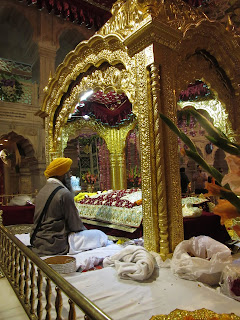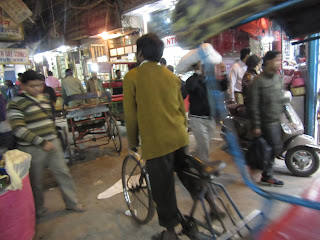After
our late night arrival in Delhi , India 11 am to see some of the city’s sights. We hired a tuk tuk
driver outside our hotel to drive us to Akshardham, a colossal temple
located on the left bank of the Yamuna
River
There
was massive security at the complex that was strictly enforced. I had read that
security there was more rigorous there than at the airport and I could attest
to that. Strictly prohibited were photography, videography, cell phones,
cameras and other electronics, outside food and drink, bags, smoking, alcohol
and other ‘addictive substances,’ improper or disrespectful dress, abusive
language, etc, etc!!
Everything
but my pen and paper had to be left in lockers except for money and passport Steven
kept in his money belt. I had not bothered lugging around a purse, even in
transit from one place to another, for at least a month and just kept a small
amount of cash in my camera case and my wee pink embroidered ‘bag’ I bought
back in Hanoi to stash my paper and notes in so I could always write notes for the
blog. It was very freeing not having my regular purse and all the stuff a woman
normally packs into it although it did mean Steven had to normally carry more stuff in
his fanny pack and backpack. But luckily my sweet man didn’t complain much at
all – phew!
I did
feel quite lost not having my camera as we spent several hours at the 100 acre
‘hymn to Hinduism and to kitsch in equal measure.’ Akshardham, which was
built by 7,000 craftsmen in only 5 years, was a tribute to Bhagwan
Swaminarayan who lived from 1781 to 1830 and was a torchbearer of Indian
culture. The first thing we saw were the Ten Dwars or Gates which
represented the 10 principal directions described in Indian culture and
reflected the Vedic sentiment of inviting goodness from everywhere to all
visitors. At the Gate of Devotion, which celebrated the Vedic tradition
of dual worship, 208 sacred sculptures showered ‘their choicest blessings on us
all.’
Pretty
amazing too were the two Peacock Gates – the peacock is a symbol of
beauty and purity and the national bird of India
The
focal point of the entire complex was the gargantuan Mandir which was also
the largest one in the world. Mandirs are sources of peace and cultural,
spiritual inspiration for people as well as centers of education. This
ostentatious mandir, built from pink stone and white marble without using any
steel, was 141 feet tall, 316 feet wide and 356 feet long and had 234 intricately
carved pillars, 9 domes and over 20,000 sculpted figures! I am sure you will
agree that there was nothing that was not done to excess at Akshardham!
The
base of the Mandir rested on the over thousand foot long Gajendra Peeth
which comprised 148 hand carved elephants and a proliferation of other sculptures of
people, animals and birds weighing in excess of 3,000 tons. I was stopped by a security guard while writing
notes about the mandir because it turned out I was not supposed to be taking
notes at all. He consulted with a supervisor who finally relented and said I
could keep my notes after I explained I was just writing a blog.
Long colonnades of red sandstone on either side of the temple separated it from 2 huge gardens. Near one of them, an exhibition room showed a film which introduced the life of the guru and celebrated the cultural past of India and its moral values.
The mosque was begun in 1644 and completed in 1658 and stands on high ground opposite the Red Fort. There was a vast set of steps leading up to the gate which featured a vaulted entrance space called an iwan.
As we entered the courtyard, we began to get an idea of the
scale of the mosque’s construction. The layout of the Jama Masjid in Delhi ,
the last great mosque built by the Mughuls and the largest in India ,
represented the epitome of the Indo-Islamic style of mosque with a courtyard: a
large space enclosed on 3 sides (north, east and south) by identical arcades
that feature at their centers a monumental gate.
The
central dome was partially obscured by the massive iwan or entrance space in front, an
architectural conundrum that even Shah Jahan’s master architects were unable to
resolve.
A basin
for ritual washing before prayers stood in the middle of the courtyard.
At the
far western end (the direction of Mecca
The porticos housed a collection of booths in which the disciples of the faith can meditate and children can learn the Koran. We left the monumental Jama Masjid via the Meena Bazaar, above and below, a busy market by the mosque's eastern approach. It sold prayer rugs, framed Koranic inscriptions and other Islamic items amidst the fragrant smoke of kebabs from the dozens of nearby food stalls. Leaving the bazaar we walked through the section of the city known as Old Delhi to get a sense of the 'real' Delhi.
Photos from our walk in Old Delhi:
It was fascinating walking down Old Delhi's main street called Chandni Chowk as it was a constant beehive of activity with pushcarts, vendors selling their wares, cars and motorcycles all competing with nonstop foot traffic weaving in and around the crowds.
In each of the temple openings, other holy men accepted religious offerings and other donations.
Above, the Red Fort: Shah Jahan moved his capital from Agra to Delhi in 1638 and set about building a formidable 'forbidden city' that included the imperial residence and government offices. The construction program entailed tearing down an eleventh century fortress. We had just seen enough forts in Agra so we gave the Red Fort a pass, content to see it from afar.
However we're not ones to pass up places of worship as you may have guessed from reading this blog so when we happened on a Sikh temple, below, we entered it too!
The Gurdwara
Sis Ganj Sahib was established in 1783 to
commemorate the martyrdom site of the ninth Sikh Guru, Tegh Bahadur, who was beheaded on the
orders of the Mughul emperor on
11
November, 1675, for refusing to
convert to Islam.
Photos of the Sikh Temple Gurdwara Sis Ganj Sahib:
The literal meaning of the Punjabi word Gurdwara is 'the
residence of the Guru' or 'the door that leads to the Guru.'
Everyone entering the temple had to wash their feet. I had never entered a Sikh temple before so was curious to see it. The temple was packed with mostly male worshipers but one of them kindly took us under his wing and showed us around his beautiful place of worship when he noticed we were interested.
Our very helpful 'guide' above who wanted nothing more than our thanks.
The prayer hall, above, and musicians, below. We were very fortunate arriving during a prayer service.
There are no idols, statues, or religious pictures in a
Gurdwara, because Sikhs worship only God, and they regard God as having no
physical form. Nor are there candles, incense, bells, or any other
ritualistic devices.
Followers could follow the music and liturgy on the huge TV screen.
We learned that Sikhs do not have ordained priests and any
Sikh can lead the prayers and recite the scriptures to the congregation. Sikhs
don't have a general official liturgy that must be used in a Gurdwara, although
there are rules for particular ceremonies.
We learned too that every Gurdwara has a Langar attached to it
where food is served to anyone without charge. The term Langar is also used for
the communal meal served at the Gurdwaras. The food served in the Langar must be simple, so as to
prevent wealthy congregations turning it into a feast that shows off their
superiority. Although Sikhs are not required to be vegetarian, only vegetarian
food is served in the Gurdwaras. This ensures that any visitor to the Gurdwara,
whatever the dietary restrictions of their faith, can eat in the Langar. As we left the service karah prasad, a sweet
vegetarian food, that had been blessed, was served. Our guide indicated we needed to receive it in cupped hands as a gift from God.
What an extremely welcoming and humbling experience we had at the Sikh temple - I shall long remember it. Feeling refreshed spiritually, we continued our walk through Old Delhi.
We walked down a maze of narrow lanes called galis and saw several sari shops before coming to Kinari Bazaar, a sparkling bridal trimming market where Hindu families could purchase every item required for their wedding festivities.
We really had to be careful as we trod down the lanes as they bustled constantly with foot and a variety of bicycle traffic.
Wedding favors and pouches.
Beyond the stone arch of Chah Rahat, above, was a typical narrow lane with old wooden balconies and verandas.
Very ornate items for sale from Nepal.
A massive planter for sale - just a tad too big for us to lug home!
I wondered where this load of clothing was heading - to a vendor, to the garbage heap, to be re-purposed in some way...
We were amused seeing the shoe tied onto the bumper to keep it from falling off!
Walking back to the Jama Masjid, we got a tuk tuk to take us back to our hotel as it was late and we wanted to call it a day.
Posted on 1/12 from our home in Littleton, Colorado.





























































From afar, you had wonderful experiences in Delhi. Lil Red
ReplyDelete